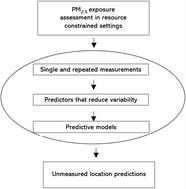当前位置:
X-MOL 学术
›
Environ. Sci.: Processes Impacts
›
论文详情
Our official English website, www.x-mol.net, welcomes your feedback! (Note: you will need to create a separate account there.)
Predictors of urban household variability of indoor PM2.5 in low socio-economic communities.
Environmental Science: Processes & Impacts ( IF 5.5 ) Pub Date : 2020-05-29 , DOI: 10.1039/d0em00035c Busisiwe Shezi 1 , Nkosana Jafta 2 , Kareshma Asharam 2 , Hasheel Tularam 2 , Lars Barregård 3 , Rajen N Naidoo 2
Environmental Science: Processes & Impacts ( IF 5.5 ) Pub Date : 2020-05-29 , DOI: 10.1039/d0em00035c Busisiwe Shezi 1 , Nkosana Jafta 2 , Kareshma Asharam 2 , Hasheel Tularam 2 , Lars Barregård 3 , Rajen N Naidoo 2
Affiliation

|
In epidemiological studies, levels of PM2.5 need to be estimated over time and space. Because of logistical constraints, very few studies have been conducted to assess the variability within and across homes and the predictors of this variability. This study evaluated within- and between-home variability of indoor PM2.5 and identified predictors for PM2.5 in homes of mothers participating in the urban Mother and Child in the Environment birth cohort study in Durban, South Africa. Thirty homes were selected from 300 homes that were previously sampled for PM2.5. Two measurements of PM2.5 levels were conducted in each home within a 1 week interval in both warm and cold seasons (four samplings per home) using Airmetrics MiniVol samplers. A linear mixed-effect model was used to evaluate within- and between-home variability and to identify fixed effects (predictors) that result in reduced variability. The PM2.5 levels in the 30 homes ranged from 2 to 303 μg m−3. The within-home variability accounted for 94% of the total variability in the log-transformed PM2.5 levels for the 30 homes. The fixed effects extracted from the repeated samplings in the present study were used to improve a previously developed multivariable linear regression model for 300 homes, and thereby increased the R2 from 0.50 to 0.54. Inclusion of fixed-effects in multivariable linear regression models resulted in a reasonably robust model that can be used to predict PM2.5 levels in unmeasured homes of the cohort.
中文翻译:

低社会经济社区中室内PM2.5的城市家庭变异性的预测因素。
在流行病学研究中,需要随时间和空间估算PM 2.5的水平。由于后勤方面的限制,很少进行研究来评估房屋内部和房屋之间的变异性以及该变异性的预测因素。这项研究评估了室内PM 2.5的家庭内部和家庭之间的变异性,并确定了参与南非德班环境城市出生队列研究的母亲家庭中PM 2.5的预测因子。从先前采样的PM 2.5的300户房屋中选择了30座房屋。两次PM 2.5测量使用Airmetrics MiniVol采样器在温暖和寒冷的季节(每个家庭进行四个采样)在1周的间隔内对每个家庭进行一次检测。线性混合效应模型用于评估家庭内部和家庭之间的变异性,并确定导致变异性降低的固定效应(预测因子)。30个家庭的PM 2.5水平范围为2到303μgm -3。在30个房屋的对数转换后的PM 2.5水平中,房屋内部的可变性占总可变性的94%。在本研究中,从重复采样中提取的固定效应用于改进先前开发的300户房屋的多元线性回归模型,从而提高了R 2从0.50到0.54。在多变量线性回归模型中纳入固定效应后,得出了一个合理可靠的模型,该模型可用于预测该队列未测家庭中的PM 2.5水平。
更新日期:2020-06-24
中文翻译:

低社会经济社区中室内PM2.5的城市家庭变异性的预测因素。
在流行病学研究中,需要随时间和空间估算PM 2.5的水平。由于后勤方面的限制,很少进行研究来评估房屋内部和房屋之间的变异性以及该变异性的预测因素。这项研究评估了室内PM 2.5的家庭内部和家庭之间的变异性,并确定了参与南非德班环境城市出生队列研究的母亲家庭中PM 2.5的预测因子。从先前采样的PM 2.5的300户房屋中选择了30座房屋。两次PM 2.5测量使用Airmetrics MiniVol采样器在温暖和寒冷的季节(每个家庭进行四个采样)在1周的间隔内对每个家庭进行一次检测。线性混合效应模型用于评估家庭内部和家庭之间的变异性,并确定导致变异性降低的固定效应(预测因子)。30个家庭的PM 2.5水平范围为2到303μgm -3。在30个房屋的对数转换后的PM 2.5水平中,房屋内部的可变性占总可变性的94%。在本研究中,从重复采样中提取的固定效应用于改进先前开发的300户房屋的多元线性回归模型,从而提高了R 2从0.50到0.54。在多变量线性回归模型中纳入固定效应后,得出了一个合理可靠的模型,该模型可用于预测该队列未测家庭中的PM 2.5水平。


























 京公网安备 11010802027423号
京公网安备 11010802027423号